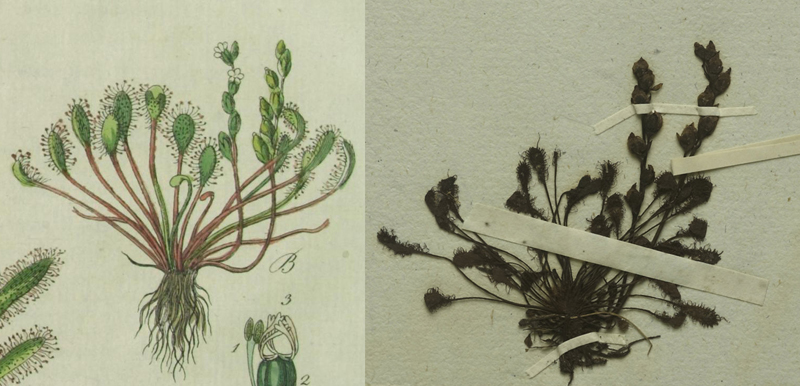Botanical detective work: carnivorous plant from Hamburg rediscovered in Munich herbarium after 220 years
SNSB botanist Andreas Fleischmann rediscovered the previously unknown original herbarium record from the description of the oblong-leaved sundew (Drosera intermedia) from 1798 – due to the match of the dried plant with the illustration from the original publication and subsequent research. Fleischmann and a colleague have now published their findings in the botanical journal Taxon.
The oblong-leaved sundew (Drosera intermedia) is a widespread carnivorous plant, known from South and North America and Europe, as well as adjacent parts of Asia. The species is well known and studied among botanists. First illustrations of this plant are in medieval herbal books as early as 1583, and the species was scientifically described in 1798 by the German botanist Friedrich Gottlob Hayne in the “Botanical Picture Book”. More astonishing is the fact that there was an original description of the plant by its discoverer from 1798, but until then there was no original proof of the plant itself, i.e. a dried specimen, which served Hayne as a basis for his description. In botany (as in zoology), it is customary for each newly discovered species to be attested by the descriptors using a so-called “type specimen.” However, in early species descriptions these vouchers were certainly used, but usually not mentioned, the type method binding exists in botany only since 1935. Since then, such named plant individuals (types) must be dried and stored in botanical collections (herbaria). Thus, they are accessible to research forever. The scientific name Drosera intermedia was given in 1798 by botanist Hayne in the publication mentioned above, but only an illustration made by the botanist himself has survived as a “type specimen.” The original specimen for the drawing, the corresponding plant and thus the original evidence for this species was missing until now.
In the search for the original specimen of the oblong-leaved sundew (i.e., the type of the species name Drosera intermedia), botanist Andreas Fleischmann, an expert on carnivorous plants at the Bavarian State Collection for Botany (SNSB-BSM), and his colleague Paulo Gonella of the Instituto Nacional da Mata Atlântica, Santa Teresa, Brazil, embarked on a detective journey through time.
Although Haynes’ original publication indicates that the plant on which the drawing was based was collected near Hamburg, Germany. Haynes’ scientific plant collection (his herbarium) is considered unknown or lost. The research of the two scientists included all large herbaria in Europe, but also a worldwide search for the document – without success.
Finally, a herbarium sheet from the Bavarian State Collection for Botany provided the decisive clue: The specimen of the oblong-leaved sundew glued there looked amazingly similar to the drawing in Haynes’ publication – down to the smallest detail! But how did this herbarium specimen come from Hamburg to Munich?
The herbarium sheet originates from the historical collection of the botanist Johann Christian Daniel von Schreber (1739-1810). The acquisition of his herbarium in 1813 is considered the formal foundation of the “Herbarium Regium Monacense” (Royal Munich Herbarium) – today’s “Munich Herbarium”. However, there are no handwritten notes by Hayne on the Munich herbarium sheet of the sundew. There are only labels and notes of Schreber and his contemporary, the botanist Albrecht Wilhelm Roth, as could be found out by comparing handwriting and historical notes. Among other things, Roth had noted on the sheet “the curled leaves contain dead insects.” Historical letters and publications prove that there was a dispute between Schreber and Roth about carnivorous plants. Roth had already put forward the thesis in 1782 (and thus almost 100 years before Charles Darwin’s fundamental work on carnivorous plants!) that some plants catch insects in order to obtain nutrients from them. Schreber rejected this claim as “incredible.” The publications also showed that Roth had personally received herbarium specimens of Drosera from Hamburg from his colleague Haynes – among them probably the specimen of Drosera intermedia collected before 1798. And it was precisely this that Roth sent to his “undiscerning” botanist colleague Schreber – presumably to convince him of his thoughts on carnivorous plants.
“We have hit an absolute bullseye with our detective work! The similarity between the Munich herbarium voucher and Hayne’s drawing is unmistakable. Physical herbarium vouchers are essential for modern research and biological naming – because in a herbarium voucher, no matter how old it is, not only the morphological characteristics, i.e. the appearance of the plant, are preserved, but also many microscopic details, constituents, up to the genetic material (DNA). Therefore, we have made the Munich herbarium specimen, demonstrably original material that Hayne saw to create his description of the species, now subsequently the reference specimen (so-called lectotype) for the species Drosera intermedia. In the Eppendorfer Moor in Hamburg, the oblong-leaved sundew is now extinct due to human influences – but the herbarium voucher has survived the last 220 years as a unique contemporary document, and shows that this plant once occurred there,” explains Fleischmann.
Publication:
Fleischmann, A. & Gonella, P.M. (2020). Typification and authorship of Drosera intermedia (Droseraceae). Taxon 68
https://onlinelibrary.wiley.com/doi/epdf/10.1002/tax.12158
Contact:
Dr. Andreas Fleischmann
SNSB – Botanische Staatssammlung München
Menzinger Str. 67, 80638 München
Tel.: 089 17861 240
fleischmann@snsb.de


